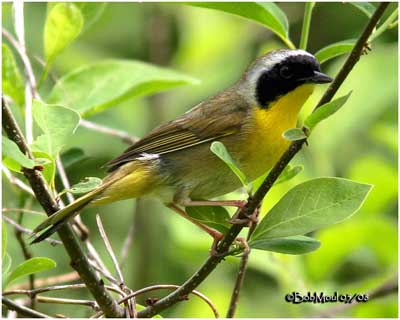
Common Yellowthroat
Geothlypis trichas
Passeriforme Order – Parulidae Family
BIOMETRICS:
Length: 11-13 cm
Wingspan: 15-19 cm
Weight: 9-10 g
LONGIVITY: Up to 10 years
DESCRITION:
Common Yellowthroats are very skulking brownish-olive and yellow little birds, with short, sharp and black bill, pinkish legs and an unusually round-tipped tail. Common Yellowthroat often shows a pale yellowish frequently incomplete eye ring.
Adult male has a facial black mask bordered above and behind by a whitish-grey band, and bright yellow throat and breast. It has white belly and undertail coverts.
Fr: Paruline masque
All : Weidengelbkehlchen
Esp : Chipe de Cara Negra
Ital : Parula golagialla comune
Nd : Maskerzanger
Russe : Желтогорлый масковый певун
Sd: Gulhake
Photographs by Bob Moul
His website: Nature Photography
Photographs by Tom Grey
His website: Tom Grey's Bird Pictures
Text by Nicole Bouglouan
Sources:
A GUIDE TO THE BIRDS OF MEXICO AND NORTHERN CENTRAL AMERICA by Steve N. G. Howell, Sophie Webb - Oxford University Press - ISBN: 0198540124
FIELD GUIDE TO THE BIRDS OF NORTH AMERICA - National Geographic Society - ISBN: 0792274512
THE HANDBOOK OF BIRD IDENTIFICATION FOR EUROPE AND THE WESTERN PALEARCTIC by Mark Beaman, Steve Madge - C.Helm - ISBN: 0713639601
All About Birds (Cornell Lab of Ornithology)
Animal Diversity Web (University of Michigan Museum of Zoology)
Birds of Nova Scotia (Robie Tufts)
What Bird-The ultimate Bird Guide (Mitchell Waite)
Wikipedia (Wikipedia, The Free Encyclopedia)

Adult female and many young males are brownish-olive above and buffy yellow below, with yellow wash only on throat, centre of upper breast and undertail coverts. Flanks and sides of breast are pale buffy brown.
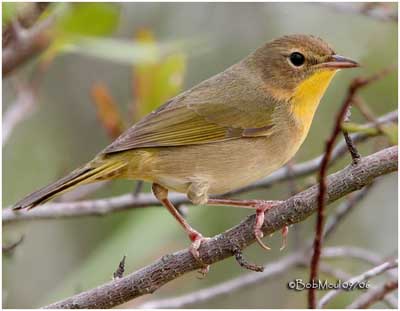
Female and young lacks the black facial mask, only beginning on the first winter bird.
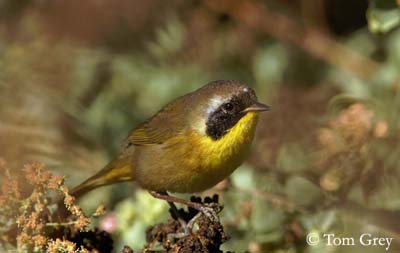
Nestlings are altricial and downy, with light orange skin, dark grey down on head, lower back and wings.
There are 13 races which differ mainly in the male’s face pattern, and the brightness of the yellow underparts
VOICE: SOUNDS BY XENO-CANTO
Common Yellowthroat’s call is a sharp, husky “chep” or “tchuck” repeatedly uttered as bird moves through vegetation. Song is a loud, rolling, but rather variable “witchity-witchity” when it’s flying.
HABITAT:
In natural range, Common yellowthroat is found in bushes, rushes, and other low cover by marshes, pools and streams, or in brushy pastures, roadsides, woodland edges and regenerating woodlands.
RANGE:
Common Yellowthroat nests in Alaska, and from Atlantic to Pacific Ocean, across Canada and US. Their wintering range is from southern US to northern South America, and into the West Indies. They migrate only for food, when insects are harder to find.
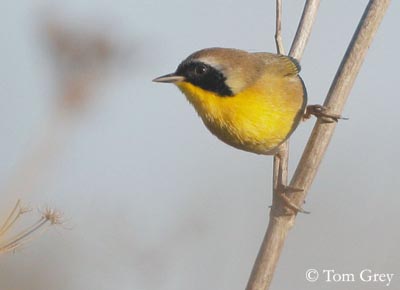
BEHAVIOUR:
Common Yellowthroat scolds an intruder in its territory; flies about while chattering chirps of “chack”, and hides in dense cover, for reappear to scold again.
Common Yellowthroat is polygamous, but monogamous for one season. Male attracts female with its song, and then follows this possible mate around to display for her. It fans its tail, flicks its wings, and presents courtship flights. Females however, show no fidelity to their mates, and often attract other males with their calls.
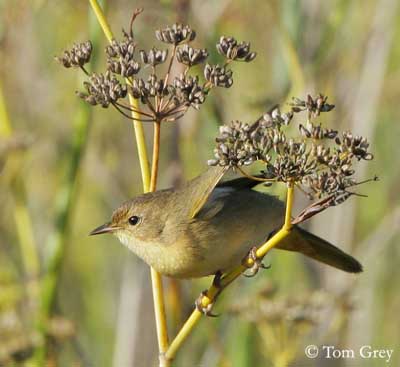
Common yellowthroat gleans leaves and bark to find insects. Because it spends a lot of time on the ground looking for food, plants are very important as cover. It also hawks insects from the air.
It’s very careful about its nest. They never fly directly to them; instead they fly to the ground and then walk to the nest.
FLIGHT:
Common Yellowthroat has a jerky flight and will dart around especially when males are scolding an intruder. It has an undulating flight display. It flies high in the air (up to 30 metres), then swoops down to a low perch, where it calls and sings.
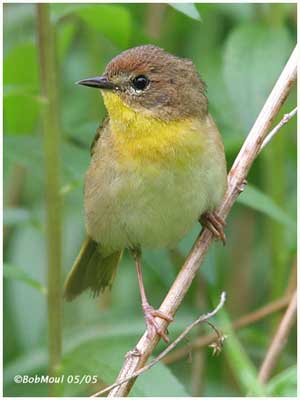
REPRODUCTION:
Common Yellowthroat’s nests are on or near the ground, usually in a clump of grass, reeds, bulrushes, weeds or low scrubs. It’s a loose bulky cup made with a variety of materials including grasses, sedges, bark, ferns, rootlets and hair. It’s lined with fine black rootlets and fine grasses. It’s built by female only.
Female lays 3 to 5 brown eggs with black spots. Incubation lasts about 12 days, by female only, but both parents tend the young. They leave the nest 8 to 10 days after hatching.
Two broods per season are common in this species.

DIET:
Common Yellowthroat is generally an insectivore. It feeds on leaves for insects and its larvae’s, such as grasshoppers, dragonflies, beetles, butterflies and spiders. It eats seeds sometimes.
PROTECTION / THREATS / STATUS:
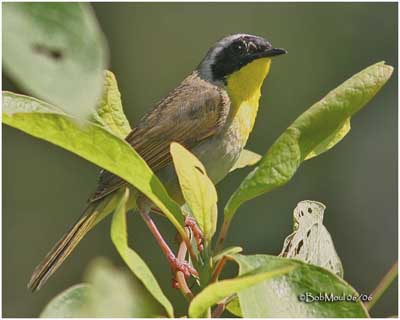
Common Yellowthroat is a very common species, and the only threats may be the parasitism by cowbirds, and the possibility of habitat loss from development of open areas or wetlands. Predators include snakes, turtles, raccoons, opossums and other animals which may find the low-lying eggs or nestlings. Adults may be attacked by hawks and owls.